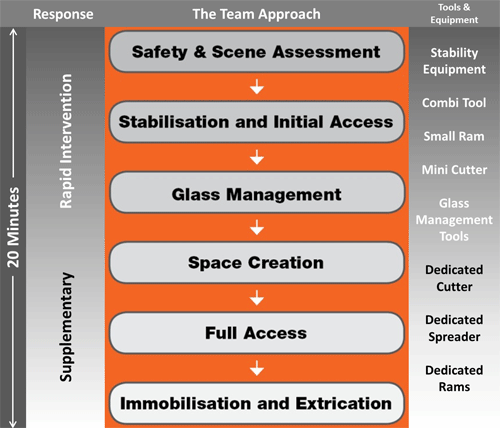Rapid Intervention (Part 2)
In my previous blog I provided a definition of Rapid Intervention, based on the Team Approach method used in attendance to road traffic collisions. It includes a two-stage response, splitting up the Team Approach based on the personnel and equipment that is likely to be on scene initially, i.e. before the arrival of additional resources. The model below gives you an idea of what this two-stage response would look like.

The implementation of the concept as described above means that rescuers have to be aware of the role they play in the Rapid Intervention response and should pre-plan and train accordingly. The splitting of the Team Approach allows crews to develop a strategy and train for a two-stage attendance; it provides a clear illustration of what is expected by the Rapid Intervention and Supplementary crews.
Dynamic on Scene
Although the approach is identical to a standard attendance (i.e. the Team Approach) the dynamic on scene will be subtly different due to reduced numbers of personnel and a smaller equipment set. The on-scene objectives of the Rapid Intervention response should be fully communicated and understood and if the incident is more complex (multiple casualties, multiple vehicles or restricted access) then it may be that creating a safe area, performing stabilisation, gaining access and establishing casualty contact is all that can be achieved prior to the Supplementary crew arriving. It is critical that Incident Commanders identify priorities and allocate their limited resources appropriately (this should also include a triage where there are multiple casualties involved). When extra personnel do arrive, safety critical information along with any plan that has been formulated must be communicated and the crews must immediately ‘gel’ to allow seamless integration and timely progression of the extrication.
Important Notice
Remember that just like with any other incident, an initial appraisal of the scene may mean that additional resources are required (in addition to the oncoming Supplementary response) and these should be ordered as soon as possible. Conversely, it may be that due to the time critical nature of the patient’s injuries the Rapid Intervention crew must extricate immediately in order that the appropriate medical interventions can be performed. Finally, the concept should be integrated into multi agency training to ensure the most effective on-scene working relationship with police and ambulance services.
Conclusion
Rapid Intervention is often talked about but rarely defined. It is becoming more common in many parts of the world and it provides Fire and Rescue Services with a different option for deploying personnel and equipment, whilst at the same time changing the type and size of vehicle that responds in the first instance. This change often calls for small, lightweight yet powerful tools and rescuers must be familiar with their use for gaining access to the patient. The Team Approach still applies, although Rapid Intervention means less people and equipment on scene in the early stages of the rescue. This requires a subtle adaptation of our thought process and crews must become familiar with the change in dynamic this approach brings. They should be aware of the clear objectives of the Rapid Intervention response and Incident Commanders must identify immediate priorities, brief the crew accordingly and oversee the arrival of additional resources to ensure continuous working. Finally, it must be remembered that such a model must incorporate multiple agencies on scene and it cannot extend extrication times: 20 minutes (or less) is still the aim and all extrication plans and activities must be guided by the dynamic condition of the patient.
As ever, I welcome your comments!
Ian Dunbar